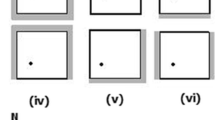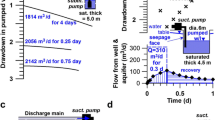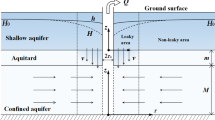Abstract
In this study, analytical and semi-analytical solutions are derived to delineate capture zone of a pumping well near a stream where a leaky layer exists between the aquifer and the stream. A groundwater regional flow is considered in the aquifer and allowed to have different angles with respect to the stream axis. Three critical pumping rates are introduced. At the first pumping rate, capture zone boundary tangents the interface between the aquifer and the leaky layer; called the in-homogeneity boundary. At the second pumping rate, capture zone boundary tangents the stream boundary and if the rate is increased, a part of pumped water would be withdrawn from the stream. The third pumping rate, which may be smaller or larger than the other two, is defined as the rate at which stream water begins to enter the leaky layer; it may or may not be captured by the pumping well. Four different capture zone configurations (cases) are analyzed for different values of pumping rates, groundwater flow directions, and leaky layer’s thickness and hydraulic conductivity. The first three cases analyze hydraulic situations whereby capture zone does not reach the stream, and hence, no pumped water is withdrawn from the stream. With the lowest pumping rate in the first case, no stream water enters the leaky layer. It enters the leaky layer but not the aquifer in the second, and enters the leaky layer and the aquifer in the third case. In the fourth case, where capture zone boundary intersects the stream, the fraction of pumped stream water to total pumped water is delineated.








Similar content being viewed by others

Abbreviations
- a :
-
Distance from the well to the in-homogeneity boundary
- B :
-
Aquifer thickness
- Cu and CC :
-
Arbitrary constants
- f :
-
Fraction of pumped stream water to total pumped water
- h and h D :
-
Leaky layer thickness and the dimensionless thickness, respectively
- i :
-
\( \sqrt{-1} \)
- K and K * :
-
Hydraulic conductivity of the aquifer and the leaky layer, respectively
- β :
-
Ratio of the leaky layer hydraulic conductivity to that of the aquifer, K * /K
- κ :
-
A dimensionless constant related to β
- q and q * :
-
Specific discharge in the aquifer and in the leaky layer, respectively
- Q and Q D :
-
Pumping rate and dimensionless pumping rate, respectively
- Q DC1 and Q DC2 and Q DC3 :
-
The first, second, and third critical pumping rates, respectively
- Q R and Q DR :
-
The (portion of pumping) rate pumped from the stream and its dimensionless value, respectively
- x and y :
-
Horizontal and vertical axes of the coordinate system, respectively
- x D and y D :
-
Dimensionless horizontal and vertical axes of the coordinate system, respectively
- y DM and x DM :
-
Maximum y D in the capture zone boundary and x D corresponding to that point
- z and z D :
-
Complex and dimensionless complex variables, respectively
- θ and θ*:
-
Angle between groundwater flow direction and the line normal to the stream axis, in the aquifer and in the leaky layer, respectively (0 o ≤ θ and θ* ≤ 90 o)
- Ω and Ω D :
-
Aquifer complex, and dimensionless complex functions, respectively
- Ω* and Ω * D :
-
Leaky layer complex, and dimensionless complex functions, respectively
- φ :
-
Hydraulic head
- φ 0 and φ *0 :
-
Constant hydraulic heads for the aquifer and the leaky layer, respectively
- Φ and Φ D :
-
Potential and dimensionless potential functions for the aquifer, respectively
- Φ 0 and Φ D0 :
-
Aquifer constant and dimensionless constant potential functions, respectively
- Φ* and Φ* D :
-
Potential and dimensionless potential functions in the leaky layer, respectively
- Φ *0 and Φ * D0 :
-
Leaky layer constant and dimensionless constant potential functions, respectively
- Ψ and Ψ D :
-
Stream and dimensionless stream functions for the aquifer, respectively
- Ψ* and Ψ * D :
-
Stream and dimensionless stream functions for the leaky layer, respectively
- Ψ DS :
-
Stream function corresponding to the capture zone boundary
References
Anderson EI (1999) Groundwater flow with leaky boundaries. Ph.D. Thesis, Department of Civil Engineering, University of Minnesota-Minneapolis
Anderson EI (2000) The method of images for leaky boundaries. Adv Water Resour 23:461–474
Asadi-Aghbolaghi M, Seyyedian H (2010) An analytical solution for groundwater flow to a vertical well in a triangle-shaped aquifer. J Hydrol 393:341–348
Asadi-Aghbolaghi M, Rakhshandehroo GR, Kompani-Zare M (2011) Analytical solutions for the capture zone of a pumping well near a stream. Hydrogeol J 19:1161–1168
Asadi-Aghbolaghi M, Rakhshandehroo GR, Kompani-Zare M (2013) An analytical approach to capture zone delineation for a well near a stream with a leaky layer. Hydrol Sci J 58(8):1813–1823
Bakker M, Anderson EI (2003) Steady flow to a well near a stream with a leaky bed. Ground Water 41(6):833–840
Bansal RK, Das SK (2011) Response of an unconfined sloping aquifer to constant recharge and seepage from the stream of varying water level. Water Resour Manag 25(3):893–911
Bear J (1972) Dynamics of fluids in porous materials. Elsevier, New York
Christ JA, Goltz MN (2002) Hydraulic containment: analytical and semi-analytical models for capture zone curve delineation. J Hydrol 262(1):224–244
Ghosh NC, Kumar S, Grützmacher G, Ahmed S, Singh S, Sprenger C, Singh RP, Das B, Arora T (2015) Semi-analytical model for estimation of unsteady seepage from a large water body influenced by variable flows. Water Resour Manag 29(9):3111–3129
Hantush MS (1965) Wells near streams with semipervious beds. J Geophys Res 70:2829–2838
Intaraprasong T, Zhan H (2007) Capture zone between two streams. J Hydrol 338:297–307
Katsifarakis KL (2008) Groundwater pumping cost minimization–an analytical approach. Water Resour Manag 22(8):1089–1099
Mahdavi A (2015) Transient-state analytical solution for groundwater recharge in anisotropic sloping aquifer. Water Resour Manag 29(10):3735–3748
Moutsopoulos KN, Tsihrintzis VA (2009) Analytical solutions and simulation approaches for double permeability aquifers. Water Resour Manag 23(3):395–415
Mylopoulos Y, Latinopoulos P, Tolikas D (1988) A dimensionless analysis in the optimal management of groundwater pollutant sources. Water Resour Manag 2(2):103–121
Polubarinova-Kochina PY (1962) Theory of ground water movement. Princeton University Press, Princeton, translated by De Wiest, JMR
Rai SN, Manglik A (2012) An analytical solution of Boussinesq equation to predict water table fluctuations due to time varying recharge and withdrawal from multiple basins, wells and leakage sites. Water Resour Manag 26(1):243–252
Samani N, Zarei-Doudeji S (2012) Capture zone of a multi-well system in confined and unconfined wedge-shaped aquifers. Adv Water Resour 39:71–84
Shan C (1999) An analytical solution for the capture zone of two arbitrarily located wells. J Hydrol 222:123–128
Sparks TD, Bockelmann-Evans BN, Falconer RA (2013) Development and analytical verification of an integrated 2-D surface water—groundwater model. Water Resour Manag 27(8):2989–3004
Stauffer F, Guadagnini A, Butler A, Franssen HJH, Wiel NV, Bakr M, Riva M, Guadagnini L (2004) Delineation of source protection zones using statistical methods. Water Resour Manag 19(2):163–185
Strack OTD (1989) Groundwater mechanics. Prentice-Hall, New Jersey
Author information
Authors and Affiliations
Corresponding author
Additional information
Submitted to Water Resources Management Journal on January 26, 2016
Rights and permissions
About this article
Cite this article
Asadi-Aghbolaghi, M., Rakhshandehroo, G.R. Delineating Capture Zone of a Pumping Well in a Slanting Regional Groundwater Flow to a Stream with a Leaky Layer. Water Resour Manage 30, 4273–4291 (2016). https://doi.org/10.1007/s11269-016-1420-9
Received:
Accepted:
Published:
Issue Date:
DOI: https://doi.org/10.1007/s11269-016-1420-9



